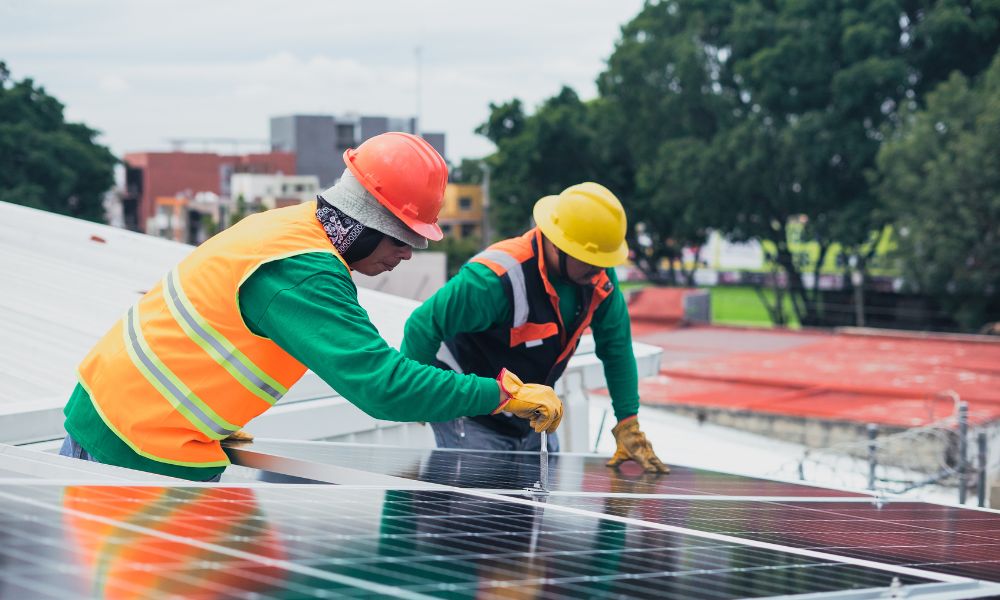How to Safeguard Solar Panels
Temperature changes and the activity of different atmospheric agents are brought on by changing seasons.
These three factors—rain, wind, and hail—are beneficial to the environment, particularly in these years of catastrophic climate change, but they may have an impact on the efficiency and output of photovoltaic panels.
Although solar panels don’t need ongoing maintenance, we must remember that the simple seasonal changes they experience could harm them. Nevertheless, are there any safeguards for the panels? What climate agents pose the most threat?
Autumn and Winter
Fall and winter are the coldest times of the year, so let’s start there.
The effects of snowfall and condensation, which colder temperatures bring about, could affect solar panels’ effectiveness. Yet, some precautions can be taken to prevent harm; let’s learn what they are all!
Ice and Snow
Due to their natural tendency to let snow accumulations flow, photovoltaic panels often don’t pose a significant threat to snowfall.
But, if there is a lot of snowfall, the weight could harm the support structure mechanically and impair energy generation.
The modules’ performance decreases noticeably, even to stop, if they are covered so they can no longer absorb the sun’s rays. In addition, if the snow is not cleared away, it may freeze, making proper operation even more difficult.
Keeping the panels clean is the best way to prevent these unforeseen incidents.
The system owner can periodically manually check to ensure no snow has accumulated due partly to anti-icing solutions (such as those used for the car’s windscreen). It will be required to call in specialized companies if there is heavy snowfall.
Condensation
Condensation happens when warm, moist air meets a cold surface, like glass, and is typical of winter mornings.
This phenomenon may, therefore, have a particular impact on the integrated roof panels, lowering their output and, over time, causing metal circuit corrosion.
The space beneath the panels must be adequately ventilated, and the panels must be opened to allow the water to evaporate to solve this issue. Only professionals with the necessary training should do this operation. Now that we’ve examined the chilly ones let’s examine the warmer seasons. Find out whether atmospheric agents affect the panels and what remedies to use.
Summer and Spring
As snow and heavy ice fall during the colder months, rain and hailstorms occur during the warmer months. Despite being a less harmful phenomenon, some methods enable us to safeguard our system.
Rain
Rain damage shouldn’t harm a well-constructed and maintained system. However, improperly put-in or older-generation panels may be susceptible to water intrusion.
Particularly in the case of non-integrated panels, harm to the house could result from water seeping into the anchoring holes (if these are not properly sealed).
Yet, in the case of integrated panels, water can seep in along the separating borders and damage the circuits. On the other hand, if the system is built into the roof, moisture may seep through the gaps between the modules and harm the metal circuits.
Any accident may be avoided, though. To verify proper solar panel installation, doing routine inspections (either on your own or with the help of specialized companies) will be sufficient.
Wind
The most frequent atmospheric factor, wind, typically does not cause harm to the panels.
This is due to the extremely small gap between solar modules and roof tiles, making it difficult for air to pass through. Instead, we must exercise caution when there are significant wind gusts, especially if our roof is flat.
The optimum solution would be to place steel supports that enable the modules to be slanted so that the wind passes through them gently.
Additionally, taking certain steps in this situation can prevent bad outcomes. The installation company must first use specialized software that mimics wind motion to analyze air currents.
Hail
Let’s examine another atmospheric occurrence typical of the warm months, especially the summer: hail. Despite popular belief, this atmospheric contaminant is among the least harmful to the panels.
This is because the latter is always positioned with a tilt towards the south, a direction where hail never occurs. The modules’ multiple layers of materials, including tempered glass, which can withstand the hits of even the heaviest atmospheric events, further increase their consistency.
Getting insurance that covers losses, even those brought on by extraordinary events, can be the right choice, even if hail does not threaten your system.
Can Heat Harm a Solar Panel as Well?
We are mistaken if we believe that the only atmospheric agents that can affect photovoltaic panels are violent ones. What we believe to be a system’s best friend, heat, frequently causes damage. The modules may overheat and perform poorly at temperatures above 25°C.
Also, taking steps to avoid the worst-case scenario is crucial.
The first step will be selecting the best portable solar panel with a good temperature coefficient. Also, you can use insulating materials or unique automated structures that can monitor the panels’ temperature and take action by shading them when overheating occurs to temporarily hide the reflective surfaces.
Conclusion
Hence, it is described here how to act to safeguard our panels from the numerous air pollutants that define the seasons.
As we’ve seen, preventing system damage is easy if we continuously monitor the system, ensure no agents settle, and maintain the cleaning activities.
We are aware that photovoltaic systems have a lot of advantages. We cannot let our fear of some events prevent us from producing healthy energy for the environment and our wallets.
Regular Inquiries
How can Photovoltaic Panels be Protected?
It is crucial to select only those built with the most up-to-date technology and maintain a consistent level of maintenance and cleanliness on the panels to protect them from atmospheric agents.
When the Sky is Cloudy, do the Panel’s Malfunction?
Even when it is cloudy, the sun still manages to reach the solar modules with some strength, allowing energy to be produced.


